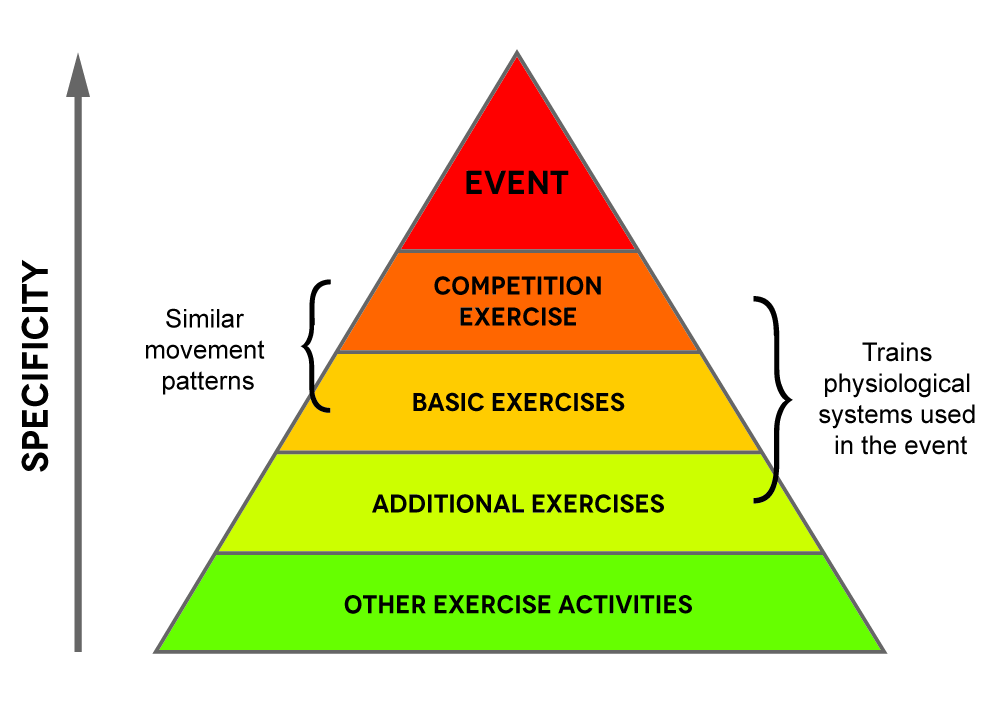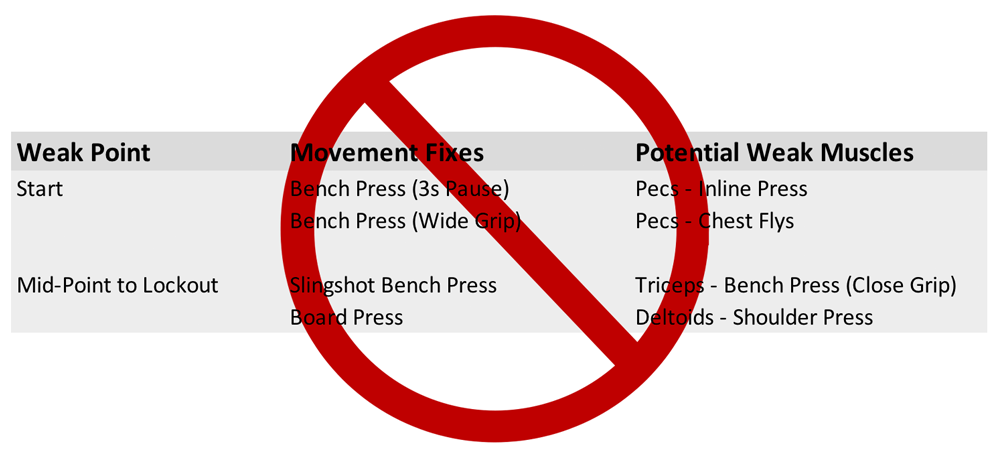All exercises can be placed into a hierarchy according to their relationship with the competition event. In our case we are talking about single repetition lifts (squat, bench press, and deadlift) and the exercises we use to support the development of maximum strength in these lifts.
Hierarchical classification of exercises helps guide the appropriate selection of exercises during critical periods of training. Let us look at the structure we will use in this app with an example based on the bench press 1RM.

Event: Bench press 1RM
An athlete may make three attempts to lift the most weight possible for a single repetition in accordance with the given rules.
Competition Exercise: Competition bench press
Practicing the competition bench press is part of regular training. While the competition event requires a single lift at maximum strength (1RM), regular training involves a variety of rep ranges and intensities.
NOTE: One person’s competition style may not be the same as someone else’s. For example, you might use a medium grip. If this is your style, you should remove it from the pool of basic exercises, since it is not a variation of your competition style. It is your competition style.
Basic Exercises: Variations of the bench press
Movements that are similar in form to the bench press but emphasize certain aspects of the lift to different degrees. For example, the paused bench press places an increased stress on the element involving initiation of the lift off the chest.
Additional Exercises: Exercises involving related muscle groups
Exercises in this classification are those unrelated to the competition movement pattern but do involve the same muscle groups. For example, the dumbbell fly and tricep dip can be used to develop muscles used in the competition bench press.
Other Exercise Activities
These are exercises and activities that do not train specific systems directly involved with the competition bench press but may facilitate performance indirectly through enhanced recovery and general well-being. This may include activities such as swimming, stretching, massages, etc.
Specificity
The more an exercise is related to the desired goal, the greater the effect progress in that exercise will have on increasing the desired goal. This is known as specificity. Specificity increases as the exercises performed in training become more similar to the performance of the competition event. Moving from the bottom of the pyramid we might move from stretching > dumbbell flyes 4×8 > paused bench press 4×2 > competition bench press 4×2 > competition bench press 1RM.
Every participant in competition attempts the bench press 1RM. It is event-specific, not athlete-specific. In contrast, each athlete has their own specific needs, and consequently, exercise selection becomes more personalized as we move down the pyramid.
Effective training, therefore, requires a delicate balance between the simultaneous demands of the event-specific and athlete-specific selection of exercises.
The Sheiko training methodology used in this app has proved enormously successful at meeting these demands for athletes participating in competitions across the world for decades.
And now it is your turn.
Addressing Weak Points
A common method encountered in the weight training community is to first identify where/why you fail in a lift and then target that “weak point” with added exercises. For example, a lifter may fail in the bench press off the chest. Paused benches and targeted pectoral work are then added to address this theorized weakness.
This targeted approach can work, however it very often fails in practice. The reason why it fails is not because it doesn’t have merits. Instead, the cause of failure is often one of a faulty analysis for one reason or another. Due to the lack of reliability of this method we will use something more robust.

Instead of beginning with a theorized weak point and then selecting exercises to address it, we can work backwards from the exercises themselves to identify which areas are weak. In other words, we can attempt variations of the competition lift that emphasize different aspects and judge our competence with these targeted “stress tests”.

In practice, we begin with the competition movement and perform variations of it during the early preparation period. An assessment is made about competence with the variation at the end of the workout it was performed. For example, if your competence with paused benches is high, it is not your weakness. Additional testing may reveal a lower level of competence with the board press. At that point, this exercise can be programmed with increased frequency and additional exercises added for the shoulders and triceps until competence in the board press increases.
Preparation Period I
Select four basic exercise variations for each of the three competition exercises. Make your selection by turning on the switch next to the exercise name. Note: You will do more than four variations in training. The rest of the basic exercise variations you do during this period will be selected by the app. On average you’ll spend
Here’s a suggestion if you have no idea which ones to pick:
- 1) Pause variations
- 2) Bands/Chains variations
These exercises will help you get the bar moving and keep it moving. Not a bad thing to aim for.
Preparation Period II
Select four basic exercises you feel are going to benefit you the most.
How do you know? Because you’ve gone through a bunch of them in Prep Period I and should now have an idea which you need to do more work with.
The app will not select any extra variations for you during this period. You’ll work with the competition exercises and your selections 100% of the time.
Here’s another suggestion if you don’t know which ones to pick:
- 1) Partial range of motion variation (e.g. board presses)
- 2) Pauses/Bands/Chains
Partial range of motion variations will help you get used to handling heavy weights as the competition approaches.
Competition Period
Narrow down your basic exercise selections to the two most important you need to work with in the final weeks before your competition. As in Prep Period II, you’ll only work with your selections and the competition exercises.